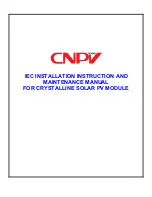
- 1 -
Ver. 6.0U _ May 31, 2011
Installation Manual for PV Modules
INSTALLATION AND USER MANUAL
FOR SHARP PHOTOVOLTAIC MODULES
NU-Q240F2 / NU-Q235F2 / NU-Q235F4 / NU-Q230F4
ND-230QCJ / ND-224QCJ / ND-216QCJ
ND-H245Q2 / ND-H240Q2 / ND-H235Q2 / ND-H230Q2
ND-Q245Q2 / ND-Q240Q2 / ND-Q235Q2 / ND-Q230Q2
ND-Q235C5 / ND-Q230C5
IMPORTANT SAFETY INSTRUCTIONS
This manual contains important safety instructions for the PV module that must be followed during the installation and the maintenance of PV modules.
PLEASE READ THIS MANUAL CAREFULLY BEFORE INSTALLING OR USING THE MODULES.
PLEASE PASS ALONG THIS MANUAL TO YOUR CUSTOMER.
A) GENERAL MANUAL
A-1. INTRODUCTION
Thank you for choosing SHARP photovoltaic (PV) module. This
Installation Manual contains essential information for electrical and
mechanical installation that you must know before installing SHARP
photovoltaic modules. These modules are listed to standard UL 1703.
This Manual also contains safety information you need to be familiar with.
All the information described in this Manual is the intellectual property of
SHARP and is based on the technologies and experience that have been
acquired and accumulated over the long history of SHARP. This Manual
does not constitute a warranty, expressed or implied. SHARP does not
assume responsibility and expressly disclaims liability for loss, damage, or
expense arising out of or in any way connected with installation, operation,
use or maintenance of PV modules. No responsibility is assumed by
SHARP for any infringement of patents or other rights of third parties that
may result from use of PV modules. SHARP reserves the right to make
changes to the product, specifications or Installation Manual without prior
notice.
A-2. GENERAL INFORMATION
(INCLUDING WARNING AND SAFETY)
The installation of PV modules requires a great degree of skill and should
only be performed by qualified licensed professionals, including licensed
contractors and licensed electricians. Please be aware that there is a serious
risk of various types of injury occurring during the installation including the
risk of electric shock. These SHARP PV modules are equipped with a
permanently attached special cable assembly for ease of installation which
does not require special assembly.
< GENERAL WARNING >
1. PV modules are heavy. Handle with care.
2. Before you attempt to install, wire, operate and maintain the PV
module, please make sure that you completely understand the
information described in this Installation Manual.
3. Contact with electrically active parts of a PV module such as terminals
can result in burns, sparks and lethal shock whether the PV modules
are connected or not.
4. PV modules produce electricity when sufficient sunlight or other
light source illuminates the module. When modules are connected
in series, voltage is cumulative. When modules are connected in
parallel, current is cumulative. PV systems can produce high voltage
and current which could present an increased hazard and may cause
serious injury or death.
5. Do not connect PV modules directly to motor loads. Variation in PV
module output power as a function of solar irradiance may damage
directly-connected loads. For example,
1: In the case of a brushless motor, the lock function may become
active and the motor may be damaged;
2: In the case of a brush type motor, the coil may be damaged.
< GENERAL SAFETY >
1. Wiring and grounding method of the frame of arrays shall comply with
national, regional and local codes, laws and standards.
2. PV modules should be installed and maintained by qualified personnel.
Only installation/service personnel should have access to the PV
module installation site.
3. Keep children away from PV modules.
4. Prior to installation, do not store modules outdoors or in a damp
environment to prevent glass from damage due to white efflorescence.
5. When PV modules are installed on roofs or any other structures
above ground, appropriate safety practices should be followed
and appropriate safety equipment should be used in order to avoid
possible safety hazards. Note that the installation of PV modules on
some roof types may require the addition of fireproofing, as required
by local building/fire codes.
6. Roof mounted PV modules are to be mounted over a fire resistant roof.
7. Only PV modules with the same cell size should be connected in series.
8. Follow all safety precautions of other components used in the system.
9. In order to avoid risk of injury or electrical shock, do not allow anyone
to handle damaged PV modules if the person is unqualified or has
limited knowledge of PV modules. Place defective PV modules in
cartons so PV cells are completely shaded, because a defective PV
module or module with broken glass may generate power even if it is
removed from the system.
10. Avoid uneven shade on the PV module surface. Shaded cells may
become hot (“hot spot” phenomenon) which may result in permanent
damage to the module (e.g., solder joints may peel off).
11. Do not clean the glass surface with chemicals. Do not let water stay on
the glass surfaces of PV modules for a long time. This creates a risk of
permanent damage to the glass, such as white efflorescence, otherwise
known as “glass disease,” which may cause reduced power output.
12. To avoid dirt accumulation or white efflorescence due to water
accumulation, do not install PV modules horizontally (flat).
13. In case of snow build up, snow would be slide down easier on the
module than other parts of the roof. When snow suddenly slide and
fall off the module’s surface, it may fall to under the roof and reach
nearby areas. Ensure that the installment of the modules would not
cause any damage to objects (carport, bicycle, entrance) nearby.
Apply appropriate safety measures and/or safety equipments (e.g.
snow stopper) when necessary.
14. Do not expose PV modules to sunlight concentrated with mirrors,
lenses or other means.
15. Turn off inverters and circuit breakers immediately, should a problem occur.
16. The maximum open circuit voltage must not be greater than the
specified maximum system voltage. Voltage is proportional to the
number of PV modules in series and is affected by weather conditions.
For strings connected in parallel take proper measures to block
reverse current flow.


























